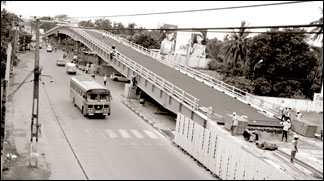Peerless engineering feat
Flyover at Peliyagoda - a new world record:
by Indeewara Thilakarathne
[email protected]
 The workers with yellow hats and in uniforms were attending to
diverse tasks at the site of the Kelaniya Railway Crossing North
Flyover. Despite the pouring rain, the site seemed to be alive with
overseeing engineers testing the concrete mixtures and directing workers
to attend the tasks at hand, from time to time. The workers with yellow hats and in uniforms were attending to
diverse tasks at the site of the Kelaniya Railway Crossing North
Flyover. Despite the pouring rain, the site seemed to be alive with
overseeing engineers testing the concrete mixtures and directing workers
to attend the tasks at hand, from time to time.
It is the rare occasion that Sri Lankan engineers together with their
co-workers proved it is possible for them even to break world records if
and when concerted effort is made with the application of appropriate
technologies.
Among other things, Kelaniya Flyover shattered into pieces the
widespread myth that foreign experts are an indispensable component in
major constructions and that the Sri Lankan professionals though equal
in qualifications and experience, are somewhat inferior to their foreign
counterparts.
However, little regard has been paid to the fact that Sri Lankan
professionals such as Dr. H.N.S Kulathilaka, Dr. Sarath Gunapala, and
Prof. Wimal Dissanayake (and many other professionals) have proved their
capabilities internationally.
If the optimal working conditions and financial backing is provided,
local experts perform well in major construction projects, contributing
to government's present drive for rapid development, especially in the
areas of mass constructions in infrastructure development.
It is obvious that the principle difference that make Sri Lankan
expatriate professionals rather comfortable in achieving tasks at hand
than their counterparts in Sri Lanka is because of the excellent working
conditions together with a good remuneration package the were offered by
their employers and not because of differences in qualification on the
part of Sri Lankan professionals.
If Government is intending in creating a indigenous technology and a
knowledge base in vital areas such as construction, food technology, IT,
it is imperative that working conditions for Sri Lankan professionals
should be further improved, offering them decent remuneration package.
 For instance, the Super Structure which was imported from UK and
fixed on to the Flyover in Kelaniya can also be constructed locally if
the necessary funding is provided. For instance, the Super Structure which was imported from UK and
fixed on to the Flyover in Kelaniya can also be constructed locally if
the necessary funding is provided.
The construction of the Kelaniya Railway Crossing North Flyover which
was commenced on and scheduled to complete by March 25, 2008 is an ample
demonstration of the capabilities of Sri Lankan engineers and the local
construction consortiums which are now par with their counter parts in
developed countries.
The Flyover with 320 metres in length and 8.85 in width is nearly
completed qualifying it to be the fastest built Flyover in the world.
Except for the Super Structure which is built by Mabey & Johnson of
UK, the entire Flyover is being constructed by a dedicate team of Sri
Lankan engineers together with extremely industrious workers who work
round the clock to reach the target. The local partner in the venture is
Access Engineering Ltd.
For the Flyover steel weighing 450 tones and 800 cubic meters of
concrete have been used in addition to the steel used for the concrete
which is 80 weights.
The entire foundation and the sub-structure of the Flyover was
designed and commissioned by a team of Sri Lankan engineers.
"Though we were aware at the commencement of the work, of the present
world record in constructing Flyover, we were simply concentrating on
the task. That is to complete the Flyover by March 25, 2008. If we were
asked to complete the work earlier than March 25, 2008, we are still
ready to achieve that target.
Sri Lankan engineers are capable of constructing any complex
structure whether it is a bridge or a Flyover.
The task is made easier by the co-operation and the discretion given
by the Access Engineering for the top manager empowering them to make
quick decisions on the site. 'Besides this Flyover, the company has
undertaken to construct 4 Flyover in Kelaniya, Panadura, Negombo, Mahawa
and Wattala.' said Senior Project Engineer Iyantha Sirisena who was
quite happy with the progress so far achieved.
Currently a workforce consisting of 115 minor workers and ten
engineers on site who are supervising the process of construction
ensuing that the construction conforms to the international standards.
The project is jointly funded by a grant of United Kingdom and
Government of Sri Lanka.
An era of technological revival similar to one where remarkable
engineering feats such as Yodha Ela, were accomplished can herald if the
government intervenes in a big way to improve the working conditions of
Sri Lankan professionals, it would not only help in putting an end to
the mass migration of professionals but also would help to attract Sri
Lankan professionals domiciled on foreign soil to return to Sri Lanka
and to make a substantial contribution to Sri Lanka. |
